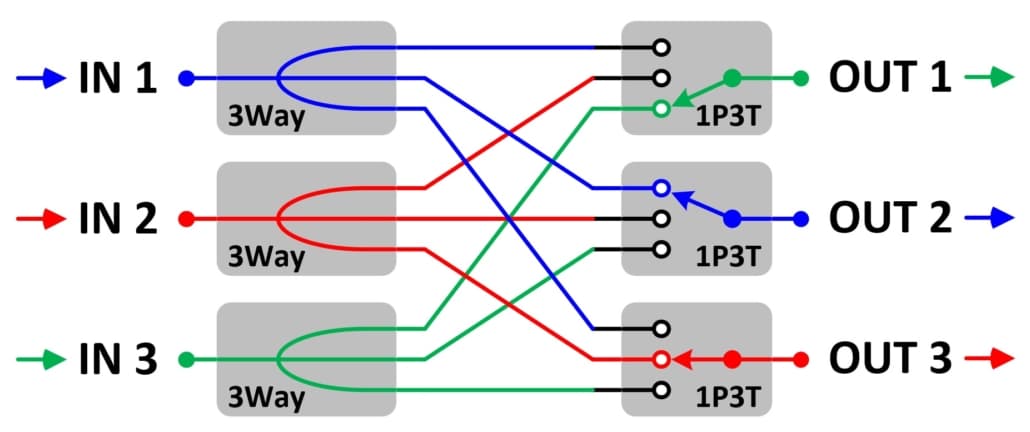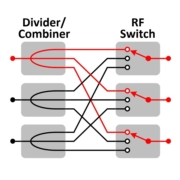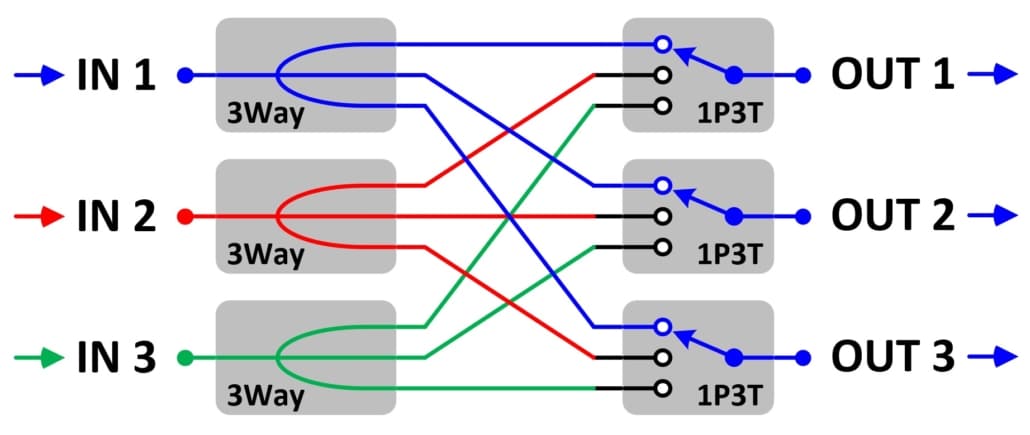How does a non-blocking matrix switch work?
A non-blocking matrix switch is constructed with power dividers and RF switches. The power dividers provide the functionality that make this design non-blocking. The power dividers fan-out the RF signal so that it is available for multiple simultaneous connections. If an input port is already connected to an output port, it is not blocked from use by other output ports. If need be, an input port can be connected to all output ports simultaneously.
Both block diagrams below have the 3-Ways on the input half of the matrix. The 3-Way dividers fan-out the input signals to be available to all output ports simultaneously. The 1P3T switches select which single input port to pass through the matrix to its output port.

In the below diagram, the 3-Way makes port IN1 available to all output switches. So, port IN1 can be set to all output ports at the same time. This is what differentiates a non-blocking matrix switch from a blocking matrix switch. A blocking matrix switch would restrict port IN1 to be connected to a single output port.
Advantages of a Non-Blocking Matrix
- An input port can be connect to multiple outputs simultaneously
Disadvantages of a Non-Blocking Matrix
- Higher insertion loss than a blocking matrix
- Not as broadband as a blocking matrix
- Lower port-to-port isolation than a blocking matrix
Maximum Number of Active Paths
For a non-blocking matrix switch, the maximum number of active paths is limited by the RF switches. If the switches are on the output half of the matrix, then the maximum number of active paths is equal to the number of output ports.
6X3 non-blocking matrix = 3 active paths maximum (if switches on OUT ports)
4X8 non-blocking matrix = 8 active paths maximum (if switches on OUT ports)
8X4 non-blocking matrix = 4 active paths maximum (if switches on OUT ports)
2X4 non-blocking matrix = 4 active paths maximum (if switches on OUT ports)
Cost Factors
The dominate factor in matrix switch cost is the total number of ports. As you increase the number of ports, the number of internal paths increases quadratically. The best way to keep costs low is to choose a matrix switch with the minimum number of ports that you require. If you would like to see pricing for several configurations to see general costing options, JFW can provide quick ROM pricing in 1-2 days.
When you shouldn’t use a non-blocking matrix switch
If you do not require an input port to be connected to multiple output ports simultaneously, then you should not use a non-blocking matrix. Instead use a blocking matrix switch. A blocking matrix switch will have lower insertion loss and higher port-to-port isolation.
Available Models
JFW offers 50 Ohm non-blocking matrix models and 75 Ohm non-blocking matrix models.




